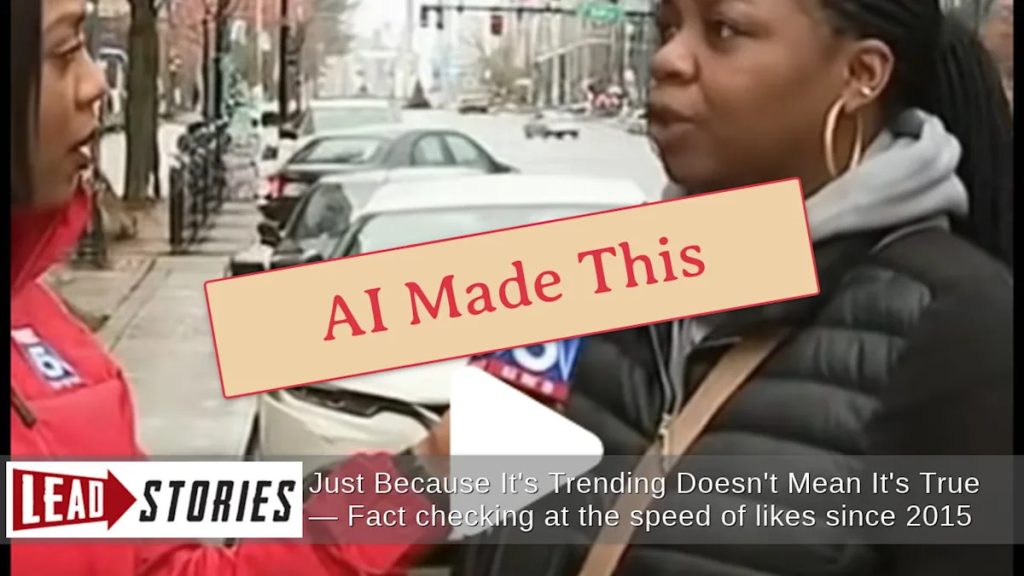Listen to the article
Local TikTok Video Fabricates Woman Selling Food Stamps, Spreading Misinformation
A viral video claiming to show an Atlanta woman openly admitting to selling $2,000 in SNAP food stamps monthly has been confirmed as a sophisticated AI fabrication, despite being shared widely across social media platforms.
The deceptive 15-second clip features what appears to be a Fox 5 Atlanta reporter interviewing a woman on a city sidewalk. In the fabricated exchange, the woman brazenly states: “I’m gonna keep it real with you. I get over $2,500 a month in stamps. I sell them, $2,000 worth, for about $1,200 to $1,500 cash. That’s why everybody’s upset. Folks say we’re taking advantage, but that’s how we get by.”
The reporter then concludes with: “And that’s the frustration we’re hearing out here in downtown Atlanta.”
Originally posted on October 28 by the TikTok account “what.if1411,” the video was properly labeled as AI-generated in its description, with hashtags clearly indicating its artificial nature. However, as the video spread to other platforms, these crucial disclaimers were removed, leading many viewers to believe they were watching authentic footage.
Verification efforts by fact-checkers revealed no such interview exists in Fox 5 Atlanta’s archives. When shown the clip, a veteran Fox 5 Atlanta journalist confirmed the “reporter” in the video is not affiliated with the station.
The TikTok channel responsible for the original post makes no secret of its content being artificial, with a profile description reading: “what IF the channel of possibilities” – signaling the hypothetical nature of its videos.
This incident highlights the growing concern around AI-generated media and its potential to spread misinformation about public assistance programs. SNAP (Supplemental Nutrition Assistance Program) benefits, commonly known as food stamps, help millions of low-income Americans afford nutritious food. In 2023, approximately 42 million people relied on the program, according to USDA data.
The fabricated narrative of widespread SNAP fraud plays into persistent stereotypes about benefit recipients. While benefit trafficking does occur, the USDA reports actual fraud rates are significantly lower than portrayed in public perception, with an overall trafficking rate of approximately 1.5% of benefits.
Social media platforms continue to struggle with the rapid proliferation of synthetic media. Despite TikTok, Meta, and other platforms implementing policies requiring disclosure of AI-generated content, enforcement remains inconsistent, and disclaimers often disappear when content is shared across different networks.
Digital literacy experts warn this case demonstrates how easily AI can be used to create content that appears authentic, especially when familiar local news branding is incorporated. The presence of recognizable elements, like the Fox 5 Atlanta microphone, lends an air of legitimacy that makes viewers less likely to question the content.
“This is particularly dangerous because it targets public perception of government assistance programs that serve vulnerable populations,” said Dr. Marcus Williams, a media ethics researcher at Emory University. “When misinformation like this spreads unchecked, it can influence public opinion and potentially impact policy decisions around these critical safety net programs.”
As AI-generated media becomes increasingly sophisticated, experts recommend viewers maintain healthy skepticism toward emotionally charged videos, especially those featuring surprising or controversial statements, and verify information through official news sources before sharing.
Verify This Yourself
Use these professional tools to fact-check and investigate claims independently
Reverse Image Search
Check if this image has been used elsewhere or in different contexts
Ask Our AI About This Claim
Get instant answers with web-powered AI analysis
Related Fact-Checks
See what other fact-checkers have said about similar claims
Want More Verification Tools?
Access our full suite of professional disinformation monitoring and investigation tools




9 Comments
This is a concerning case of AI-generated misinformation spreading on social media. It’s crucial that we remain vigilant and fact-check claims before sharing them, to prevent the further spread of false narratives.
You’re right, the deceptive nature of this video is alarming. It’s a good reminder to always be skeptical of unverified content, especially when it involves sensitive social issues.
It’s disappointing to see how easily this fabricated video was able to spread and gain traction before being debunked. This underscores the need for robust fact-checking mechanisms and media literacy education.
Absolutely. The rapid spread of this type of disinformation is a real challenge. Fact-checkers and platforms must work together to quickly identify and remove such content before it can do further harm.
This case highlights the need for greater media literacy and critical thinking when it comes to online content. While AI can create very realistic videos, it’s crucial to look beyond the surface and fact-check claims.
Well said. Developing the skills to identify AI-generated or manipulated content is becoming increasingly important in our digital age. Responsible social media use is key to combating the spread of misinformation.
While the use of AI to create misleading content is concerning, I’m glad to see the disinformation commission was able to quickly verify and debunk this particular video. Ongoing vigilance is crucial to combat the spread of fake news.
I appreciate the fact-checking efforts to debunk this fabricated video. Spreading misinformation, even inadvertently, can have real-world consequences, so it’s important to rely on reputable sources.
Agreed. The use of AI to create such convincing yet false content is a growing challenge. We must be diligent in verifying information before sharing, to avoid contributing to the spread of disinformation.